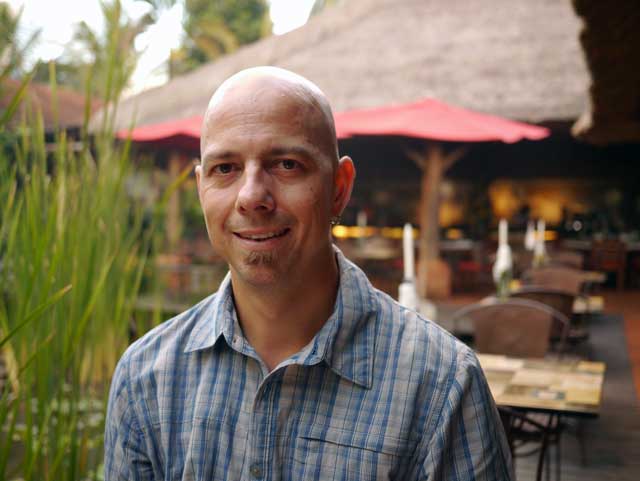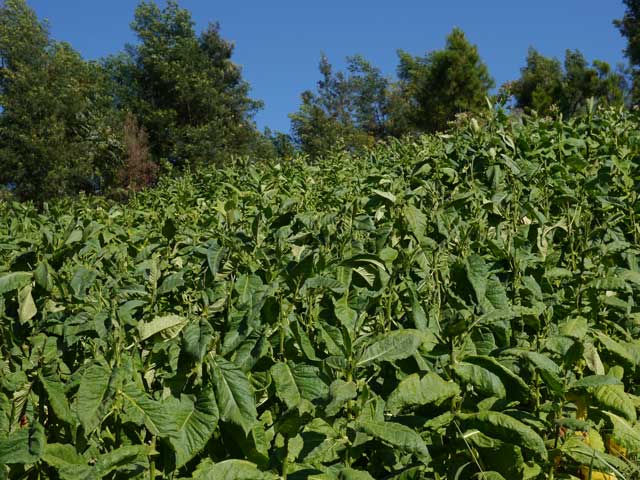We were so happy when we arrived back in Ubud for a second visit. We spent a week repeating some of our favorite activities, but mostly we enjoyed new restaurants and explored Balinese culture through new activities.
We took two of Les Leventhal’s yoga classes. Les recently moved from San Francisco to Bali. He led us in chanting Ganesha, Ganapadi. Here is a statue at the yoga studio of the Hindu god Ganesha.

After eating our fill of Indonesian food during the last five weeks, we branched out to other cuisines. Ubud is home to many ex-pats from all over the world, and some have opened restaurants here. One of our favorites was the Melting Wok. Owned by a French couple named Geraldine and Phillipe, the food had Thai spicing, like this curry dish flavored with lemon grass and basil.

The desserts at the Melting Wok were outstanding. This is coconut crème caramel, which had a texture like flan.

Another favorite restaurant was Taco Casa, a truly California-Mexican restaurant that served pitchers of good margaritas and entrees like this “eight layer burrito”.

We also ate at Il Giardino, a delicious and authentic Italian restaurant. We enjoyed their garden setting.

Here’s a photo of their anchovy, carmelized onion and olive pizza. We also loved their house made paperdelle with lamb sugo.

We went on a Bali bird walk. Here is our guide Victor Mason, an irrepressible Brit who has lived in Ubud for over 40 years.

Victor proudly told us that he never wears shoes.

The bird walk included about 10 people, and went through rice fields and along irrigation canals.

We saw over 20 different types of birds on our walk. This is a Javan Pond Heron. We saw these in India too.

Also hanging out in the rice fields were Wood Sandpipers and a White-breasted Waterhen.


Our favorite bird was the Java Kingfisher, with its beautiful bright blue feathers. We also saw Collared and Sacred Kingfishers, but they are both less colorful.

We watched this snake, who stayed in this pose for over a minute.

We drank fresh coconut water from coconuts that this man harvested.

There were many different varieties of dragonflies.

This is a Chocolate Pansy butterfly.

Victor was so knowledgeable about the birds and butterflies, and he has written several books. We looked at his Butterflies of Bali book with its incredible illustrations, and decided to buy a copy for ourselves.

One morning we rode bikes through the countryside. Here we are with our guide Gede.

Here the rice terraces were steep, so we walked our bikes up this part of the trail.

Pushed by the Indonesian government, most of the rice grown in Ubud is GMO rice from Monsanto. This man is weeding his rice field.

Gede told us that the farmers now have to also buy Monsanto pesticide and fertilizer in order to get adequate rice yields. Spraying pesticide in the fields was a common sight.

At the end of the ride we opted to hike to our lunch spot, so we got to walk through these rice fields.

Our guide explained that the daily leaf plate offerings change every day. August 24th honored metal, so vehicles and electronic devices had offerings.

This woman and her son are on the way to the temple with an offering for the gods. The blue cans are Pocari Sweat, which is a Japanese beverage similar to Gatorade. Apparently the Gods need electrolytes, too.

Several times we walked past this building near a temple and saw many people preparing offerings together. The men were out front while the women you see here were in this covered area.

It was a full moon again while we were in Ubud. We felt so fortunate to see this sight twice!

Cock fighting as an animal sacrifice is part of Balinese Hinduism. The blood of the rooster that loses is considered to be an offering to the evil spirits. This rooster is probably about two years old.

We enjoyed several dance performances. This dance is the bumble bee dance. The two dancers represent bees that fall in love in a flower garden.

The dancers were accompanied by a live gamelan orchestra, which was a joy to hear and watch.

Check out these long fingernails!

An important part of Balinese dance is expressive eye movements.

This is a Legong dance. Developed in the 19th century, it was originally performed only for royalty.

Her finger movements were so delicate. It's no surprise when we learned that dancers are chosen for large eyes and long fingers.

After her dance, she took a break and checked her email.

The male dancers also have expressive eyes.


This is a Barong. As the Barong dances he chatters his teeth. It took two people to dance with this costume.

Here he looks like a cute chihuahua!

Rangda the witch is the epitome of evil, while the Barong personifies good. To the Balinese, these forces are constantly in battle in the world, and to live appropriately one must work to keep these forces in balance.

The male dancers are fighting the evil Rangda.

We will treasure our memories of our return visit to Ubud.

We took two of Les Leventhal’s yoga classes. Les recently moved from San Francisco to Bali. He led us in chanting Ganesha, Ganapadi. Here is a statue at the yoga studio of the Hindu god Ganesha.

After eating our fill of Indonesian food during the last five weeks, we branched out to other cuisines. Ubud is home to many ex-pats from all over the world, and some have opened restaurants here. One of our favorites was the Melting Wok. Owned by a French couple named Geraldine and Phillipe, the food had Thai spicing, like this curry dish flavored with lemon grass and basil.

The desserts at the Melting Wok were outstanding. This is coconut crème caramel, which had a texture like flan.

Another favorite restaurant was Taco Casa, a truly California-Mexican restaurant that served pitchers of good margaritas and entrees like this “eight layer burrito”.

We also ate at Il Giardino, a delicious and authentic Italian restaurant. We enjoyed their garden setting.

Here’s a photo of their anchovy, carmelized onion and olive pizza. We also loved their house made paperdelle with lamb sugo.

We went on a Bali bird walk. Here is our guide Victor Mason, an irrepressible Brit who has lived in Ubud for over 40 years.

Victor proudly told us that he never wears shoes.

The bird walk included about 10 people, and went through rice fields and along irrigation canals.

We saw over 20 different types of birds on our walk. This is a Javan Pond Heron. We saw these in India too.

Also hanging out in the rice fields were Wood Sandpipers and a White-breasted Waterhen.


Our favorite bird was the Java Kingfisher, with its beautiful bright blue feathers. We also saw Collared and Sacred Kingfishers, but they are both less colorful.

We watched this snake, who stayed in this pose for over a minute.

We drank fresh coconut water from coconuts that this man harvested.

There were many different varieties of dragonflies.

This is a Chocolate Pansy butterfly.

Victor was so knowledgeable about the birds and butterflies, and he has written several books. We looked at his Butterflies of Bali book with its incredible illustrations, and decided to buy a copy for ourselves.

One morning we rode bikes through the countryside. Here we are with our guide Gede.

Here the rice terraces were steep, so we walked our bikes up this part of the trail.

Pushed by the Indonesian government, most of the rice grown in Ubud is GMO rice from Monsanto. This man is weeding his rice field.

Gede told us that the farmers now have to also buy Monsanto pesticide and fertilizer in order to get adequate rice yields. Spraying pesticide in the fields was a common sight.

At the end of the ride we opted to hike to our lunch spot, so we got to walk through these rice fields.

Our guide explained that the daily leaf plate offerings change every day. August 24th honored metal, so vehicles and electronic devices had offerings.

This woman and her son are on the way to the temple with an offering for the gods. The blue cans are Pocari Sweat, which is a Japanese beverage similar to Gatorade. Apparently the Gods need electrolytes, too.

Several times we walked past this building near a temple and saw many people preparing offerings together. The men were out front while the women you see here were in this covered area.

It was a full moon again while we were in Ubud. We felt so fortunate to see this sight twice!

Cock fighting as an animal sacrifice is part of Balinese Hinduism. The blood of the rooster that loses is considered to be an offering to the evil spirits. This rooster is probably about two years old.

We enjoyed several dance performances. This dance is the bumble bee dance. The two dancers represent bees that fall in love in a flower garden.

The dancers were accompanied by a live gamelan orchestra, which was a joy to hear and watch.

Check out these long fingernails!

An important part of Balinese dance is expressive eye movements.

This is a Legong dance. Developed in the 19th century, it was originally performed only for royalty.

Her finger movements were so delicate. It's no surprise when we learned that dancers are chosen for large eyes and long fingers.

After her dance, she took a break and checked her email.

The male dancers also have expressive eyes.


This is a Barong. As the Barong dances he chatters his teeth. It took two people to dance with this costume.

Here he looks like a cute chihuahua!

Rangda the witch is the epitome of evil, while the Barong personifies good. To the Balinese, these forces are constantly in battle in the world, and to live appropriately one must work to keep these forces in balance.

The male dancers are fighting the evil Rangda.

We will treasure our memories of our return visit to Ubud.


































